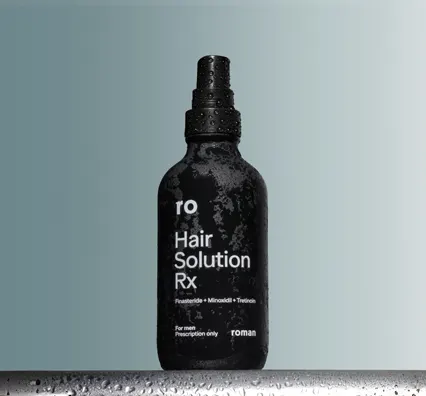Here's what we'll cover
Here's what we'll cover
Dealing with hair loss can be a stressful and frustrating journey. Finasteride has long been a first-line treatment for hair loss in men and for good reason. Studies have long shown that finasteride can slow or stop hair loss in many men.
In 1997, oral finasteride (Propecia) was FDA-approved for the treatment of androgenetic alopecia (AGA) in male patients. Known as male pattern baldness, AGA occurs in up to 50% of men over age 50.
In recent years, topical finasteride has been gaining in popularity. Though it’s not FDA-approved to treat hair loss, early studies show it may deliver similar results to oral finasteride without some of the side effects.

What is topical finasteride?
Topical finasteride contains the same active ingredient found in the oral medication. Instead of a tablet, it’s applied to the scalp using a spray, gel, or dropper. Like oral finasteride, topical finasteride is in a class of drugs called 5-alpha-reductase inhibitors. These medications limit the production of enzymes responsible for the conversion of testosterone to dihydrotestosterone (DHT). DHT is linked to both BPH and hair loss.
Studies show that people with pattern hair loss have higher levels of DHT in the scalp. This can cause hair follicles to shrink. Over time, the follicles produce thinner hairs and, eventually, there’s hair loss. Limiting DHT helps slow hair loss and promote hair regrowth.
Though it’s not FDA-approved to treat hair loss, there’s been an increase in off-label prescribing of topical finasteride.
Does topical finasteride work?
Decades of research have shown the effects of oral finasteride treatment. A clinical trial early on showed it stopped hair loss in 83% of men with male pattern baldness who took it for two years. Additional studies show it can slow hair loss in as little as 3 months and extend hair growth for 10 years.
Newer research shows a topical application is also effective. A 2022 randomized, controlled trial found topical finasteride significantly improved hair count compared to a placebo. It was also well tolerated. Its effect on hair density was found to be similar to that of oral finasteride, but with lower systemic side effects.
Results may vary, but some men report decreased hair loss and increased hair regrowth that’s noticeable in 4-6 months. Most see the biggest improvement in hair growth after 12 months.
As with oral finasteride, keeping the hair requires continued use. The hair growth seen with oral finasteride can last for up to 12 months after you stop taking it. More research is needed to see how long the effects of topical finasteride last.
The key to success with any hair loss approach is starting early. If the hair follicle has shrunk too much, it can be hard to restore. Treatments sometimes don’t work in areas that have gone entirely bald.
Side effects of topical finasteride
In some cases, topical finasteride can cause itching, dryness, flaking, or burning where it’s applied. Usually, these effects are mild when they occur and go away if you stop using the product.
Because it does not enter the bloodstream in the same way, topical finasteride appears to reduce the risk of side effects. This includes sexual side effects. However, it’s important to recognize that even as a topical medication, finasteride does lower DHT levels in the blood. While it’s less likely with topical formulas, some men may experience similar side effects as oral finasteride, which can include:
Pain in the testicles
Ejaculation problems/reduced semen volume
Dizziness
Weakness
Allergic reactions (skin rash, itching, shortness of breath)
Swelling in the face, eyelids, hands or feet
It’s important not to exceed a suggested dose, which is easier to do with a topical solution. Applying more than the recommended dose of a topical formulation does not improve hair loss or boost regrowth. This could increase potential side effects.
Finasteride warnings: All finasteride products carry specific warnings. The products should not be used or touched by women who may become pregnant or by children. The drug can affect male genital development in the womb and during development. There are some cases when finasteride is prescribed off-label in postmenopausal women with female pattern hair loss.
Finasteride can also affect testing for prostate cancer. It can lower levels of the Prostate-specific antigen (PSA). This common screening test can help detect cancer early. If you are using finasteride, it’s best to talk to your doctor about PSA testing and prostate cancer risk.
As with any medication, it’s important to talk about your health history and the medications you are taking with your healthcare providers, including eye doctors. This includes reviewing any potential drug interactions.
Topical finasteride vs. oral finasteride
In the U.S., both oral and topical finasteride require a prescription. Oral finasteride is FDA-approved to treat male pattern hair loss (1 mg) and symptoms of BPH (5mg). Topical finasteride is not FDA-approved. In recent years, prescriptions have been filled in compounding pharmacies, which can lead to inconsistency in product quality. There are now formulas online that offer consistency and quality assurance.
The major difference between topical and oral formulas is how the drugs are absorbed. Studies show both topical and oral formulas lower serum DHT levels throughout the body. With topical formulas, the reduction in scalp DHT is more localized. At the same time, the amount of finasteride in the bloodstream can be as much as 100 times lower compared to oral finasteride.
A double-blind, randomized trial comparing a twice-daily 1% finasteride gel and a once-daily 1mg finasteride tablet taken by men for 6 months, found similar results in both groups. Follow-up clinical studies are needed to learn more about long-term results.
Should you combine finasteride treatments?
Combining oral and topical finasteride treatment options is not recommended. That’s because the goal is to lower DHT enough to prevent hair loss. Excessive finasteride doesn’t improve hair loss but may increase side effects.
Another 5α-reductase inhibitor called dutasteride has also been used to treat BPH and hair loss. Dutasteride is not FDA-approved for hair loss but can be prescribed off-label.
Topical finasteride vs. topical minoxidil
Topical finasteride and topical minoxidil have both been found to help prevent hair loss and improve hair growth. They work in different ways. Finasteride works by reducing DHT. Minoxidil (Rogaine) appears to stimulate hair growth by increasing blood flow and nutrients to the hair follicles. Minoxidil also keeps hair follicles in the growth (anagen) phase longer.
Comparing similar strengths, finasteride is considered a more effective drug for those with pattern hair loss. A topical minoxidil solution, which comes in two strengths, 2% or 5%, can be used by more people, including women. Some see results using minoxidil within 8 weeks of treatment, with maximum improvement after about 4 months. The most common side effects of topical minoxidil are scalp irritation and redness. Both minoxidil and finasteride can trigger hair shedding before hair regrowth.
Should you combine finasteride and minoxidil?
Because they work in different ways, topical finasteride and topical minoxidil are often combined with improved results. Oral finasteride is also frequently used with minoxidil.
Personalizing a treatment plan
Many hair restoration plans combine a variety of approaches. This often includes finasteride, minoxidil, and other options, including nutrients, that can boost hair health.
Overall, it’s best to speak with a healthcare provider to customize a hair loss treatment plan that works for you. Oral finasteride has been considered one of the most effective ways to treat hair loss for years, but topical finasteride is quickly becoming a viable alternative that may result in the same results with much fewer side effects.
DISCLAIMER
If you have any medical questions or concerns, please talk to your healthcare provider. The articles on Health Guide are underpinned by peer-reviewed research and information drawn from medical societies and governmental agencies. However, they are not a substitute for professional medical advice, diagnosis, or treatment.
Finasteride Important Safety Information: Read more about serious warnings and safety info.
Oral Minoxidil Important Safety Information: Read more about serious warnings and safety info.
Badri, T., Nessel, T. & Kumar D. (2021). Minoxidil. In: Stat Pearls. Retrieved February 17, 2023, from https://www.ncbi.nlm.nih.gov/books/NBK482378/
Gupta, A. K. & Talukder, M. (2022). Topical finasteride for male and female pattern hair loss: Is it a safe and effective alternative? Journal of Cosmetic Dermatology , 21 (5), 1841–1848. doi:10.1111/jocd.14895. Retrieved from https://pubmed.ncbi.nlm.nih.gov/35238144/
Gupta, A. K., Talukder, M., & Williams, G. (2022). Comparison of oral minoxidil, finasteride, and dutasteride for treating androgenetic alopecia. The Journal of Dermatological Treatment, 33 (7), 2946–2962. doi:10.1080/09546634.2022.2109567. Retrieved from https://pubmed.ncbi.nlm.nih.gov/35920739/
Ho, C., Sood, T. & Zito, P. (2022). Androgenetic alopecia. Stat Pearls. Retrieved Feb. 17, 2023 from https://www.ncbi.nlm.nih.gov/books/NBK430924/
Iamsumang, W., Leerunyakul, K., & Suchonwanit, P. (2020). finasteride and its potential for the treatment of female pattern hair loss: Evidence to date. Drug Design, Development and Therapy , Volume 14 , 951–959. doi:10.2147/dddt.s240615. Retrieved from https://www.ncbi.nlm.nih.gov/pmc/articles/PMC7060023/
Mysore, V. (2012). Finasteride and sexual side effects. Indian Dermatology Online Journal , 3 (1), 62. doi:10.4103/2229-5178.93496. Retrieved from https://www.ncbi.nlm.nih.gov/pmc/articles/PMC3481923/
Piraccini, B. M., Blume-Peytavi, U., Scarci, F., et al. (2021). Efficacy and safety of topical finasteride spray solution for male androgenetic alopecia: A phase III, randomized, controlled clinical trial. Journal of the European Academy of Dermatology and Venereology , 36 (2), 286–294. doi:10.1111/jdv.17738. Retrieved from https://www.ncbi.nlm.nih.gov/pmc/articles/PMC9297965/
Salisbury, B. & Tadi, P. (2022). 5 alpha reductase inhibitors. Stat Pearls. Retrieved Feb. 17, 2023, from https://www.ncbi.nlm.nih.gov/books/NBK555930/
Sattur, S. S. & Sattur, I. S. (2021). Pharmacological management of pattern hair loss. Indian Journal of Plastic Surgery , 54 (04), 422–434. doi:10.1055/s-0041-1739254. Retrieved from https://www.ncbi.nlm.nih.gov/pmc/articles/PMC8719956/
Shapiro, J. & Kaufman, K. D. (2003). Use of finasteride in the treatment of men with androgenetic alopecia (male pattern hair loss). The Journal of Investigative Dermatology. Symposium proceedings. Retrieved Feb. 17, 2023, from https://www.sciencedirect.com/science/article/pii/S0022202X15529357
Suchonwanit, P., Srisuwanwattana, P., Chalermroj, N., et al. (2018). A randomized, double-blind controlled study of the efficacy and safety of topical solution of 0.25% finasteride admixed with 3% minoxidil vs. 3% minoxidil solution in the treatment of male androgenetic alopecia. Journal of the European Academy of Dermatology and Venereology , 32 (12), 2257–2263. doi:10.1111/jdv.15171. Retrieved from https://pubmed.ncbi.nlm.nih.gov/29972712/
Traish, A. M. (2020). Health risks associated with long-term finasteride and dutasteride use: It's time to sound the alarm. The World Journal of Men's Health , 38 (3), 323. doi:10.5534/wjmh.200012. Retrieved from https://www.ncbi.nlm.nih.gov/pmc/articles/PMC7308241/
Zito, P., Bistas, K., & Syed, K. (2022). Finasteride. Stat Pearls. Retrieved Feb. 17, 2023, from https://www.ncbi.nlm.nih.gov/books/NBK513329/









